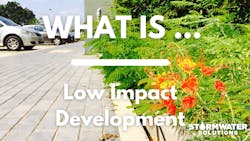The U.S. EPA defines Low Impact Development (LID) as referring “to systems and practices that use or mimic natural processes that result in the infiltration, evapotranspiration or use of storm water in order to protect water quality and associated aquatic habitat.”
Low impact development uses natural resources to manage storm water as close to its source as possible, adds EPA. LID practices use retention, detention and filtration of runoff, according to The University of Connecticut Stormwater Quality Manual.
According to The Minnesota Pollution Control Agency, low impact development and green infrastructure (GI) are terms that are used interchangeably. LID/GI aims to “preserve, restore and create green space using soils, vegetation, and rainwater harvest techniques.”
What are Examples of Low Impact Development?
Examples of low impact development include: rain gardens, trees and shrubs, storm water reuse, rainwater harvesting, green roofs, permeable pavement, ribbon curbs, and open space development.
Additionally, according to EPA, LID techniques can be applied at any development stage, whether it be developed or undeveloped.
For example, in undeveloped areas, protecting open spaces and natural areas such as wetlands, installing bioretention areas and reducing pavement are part of the early design process.
In developed areas, LID practices can mean directing roof drainage to a rain garden and retrofitting streets to capture and infiltrate rainwater.
According to UConn, it is possible to use LID principles and practices in any “land planning type, soils, climate or hydrologic regime.” Most often, LID is used after issues with storm water have already been occurring with current structures.
What are the Benefits of Low Impact Development?
Instead of allowing water runoff into ditches and storm drains, LID generally retains rainwater with the intent of it soaking into the ground, avoiding contributing to flooding and pollution as a result.
EPA recognizes there are many benefits to LID, including:
- Mitigating the urban heat island effect;
- Mitigating climate change;
- Saving energy;
- Reducing air pollution;
- Increasing property values; And
- Increasing groundwater recharge.
For instance, with green roofs, as well as ideal locations for trees for shading, LID can achieve energy savings. Even further, the use of LID promotes water conservation, particularly with the use of rainwater as a supplemental water supply.
Aesthetically, LID can liven community spaces by fitting more into the landscape, as opposed to traditional storm water management practices, which include: pipes, outfalls, concrete channels and fenced basins.
Cost-savings are also a benefit of LID practices.
According to EPA, examples of potential cost-savings with LID include:
- Saving money by reducing the amount of pavement, curbs and gutters needed;
- Saving money by eliminating the need for costly runoff detention basins and pipe delivery systems;
- Saving money by reducing site grading and building preparation costs;
- Increasing the number of lots available for sale;
- Increasing the value and sale price of residential lots; And
- Using existing trees and vegetation, saving money by reducing landscaping costs and decreasing storm water volume.
Beyond these core benefits, LID is still considered a new storm water management technology and according to UConn, was first described in 1999 in the Prince George’s County, Maryland, Low-Impact Development Design Strategies: An Integrated Design Approach.






